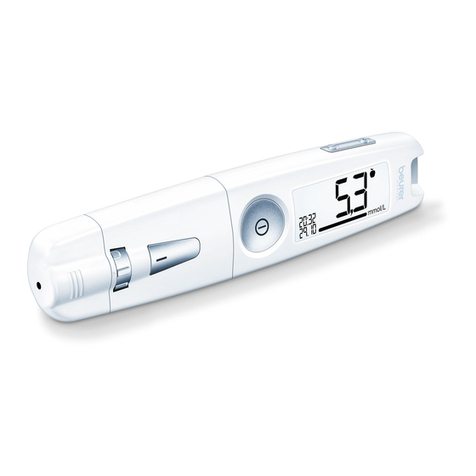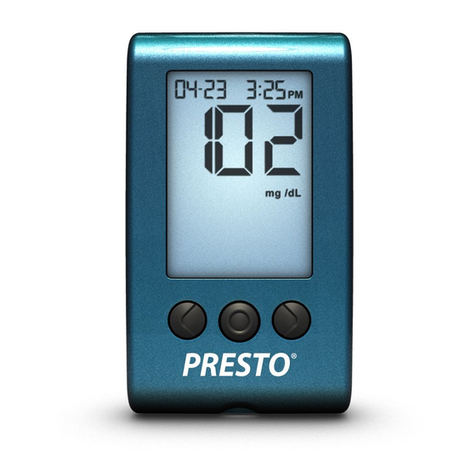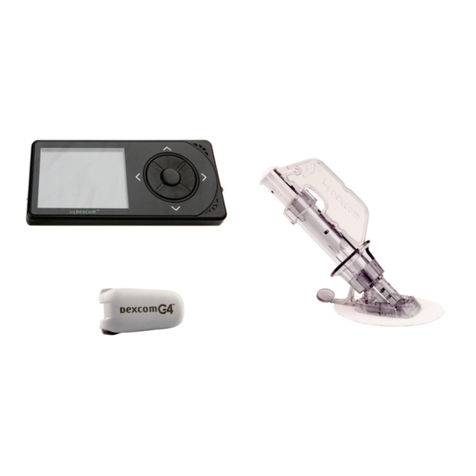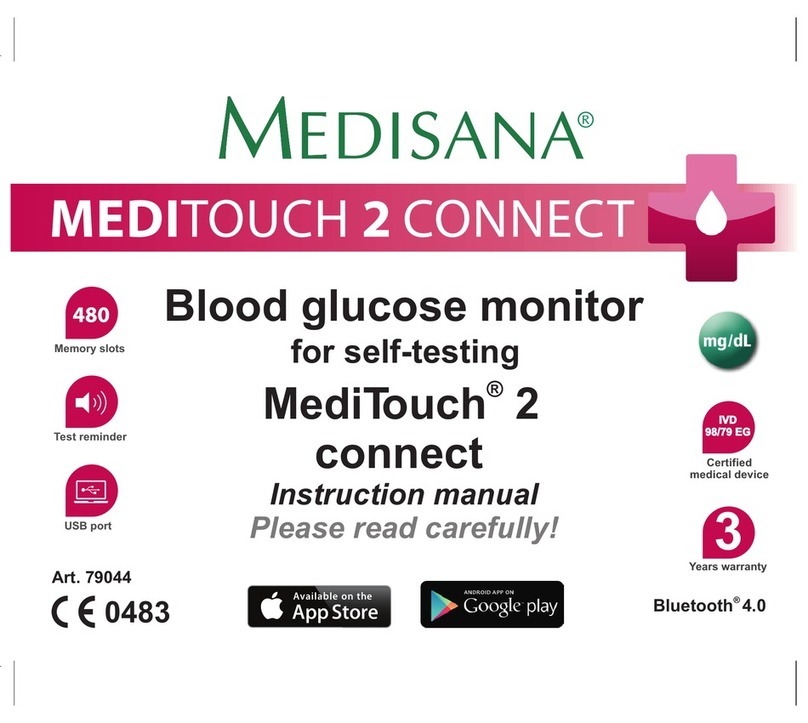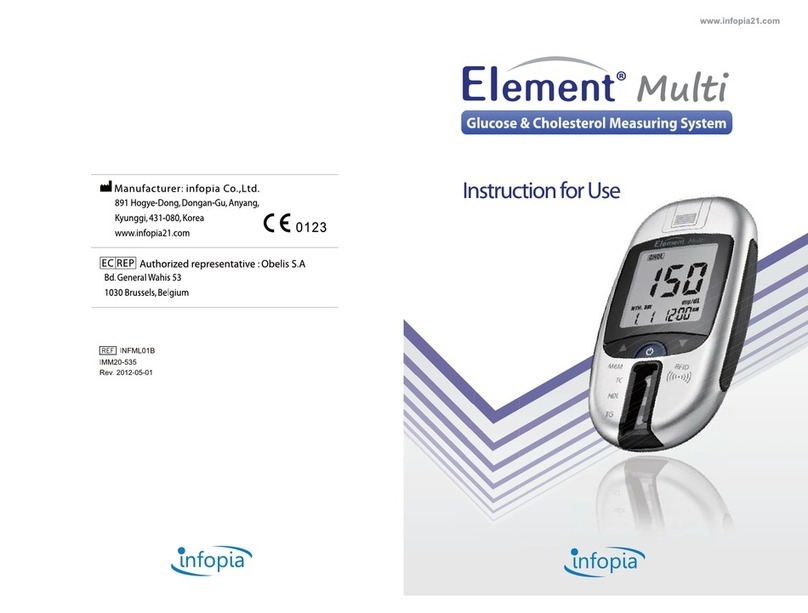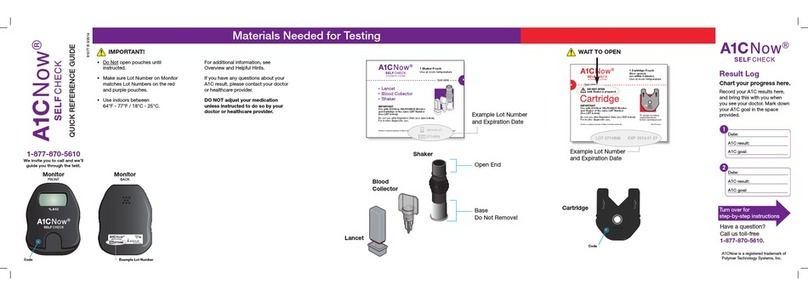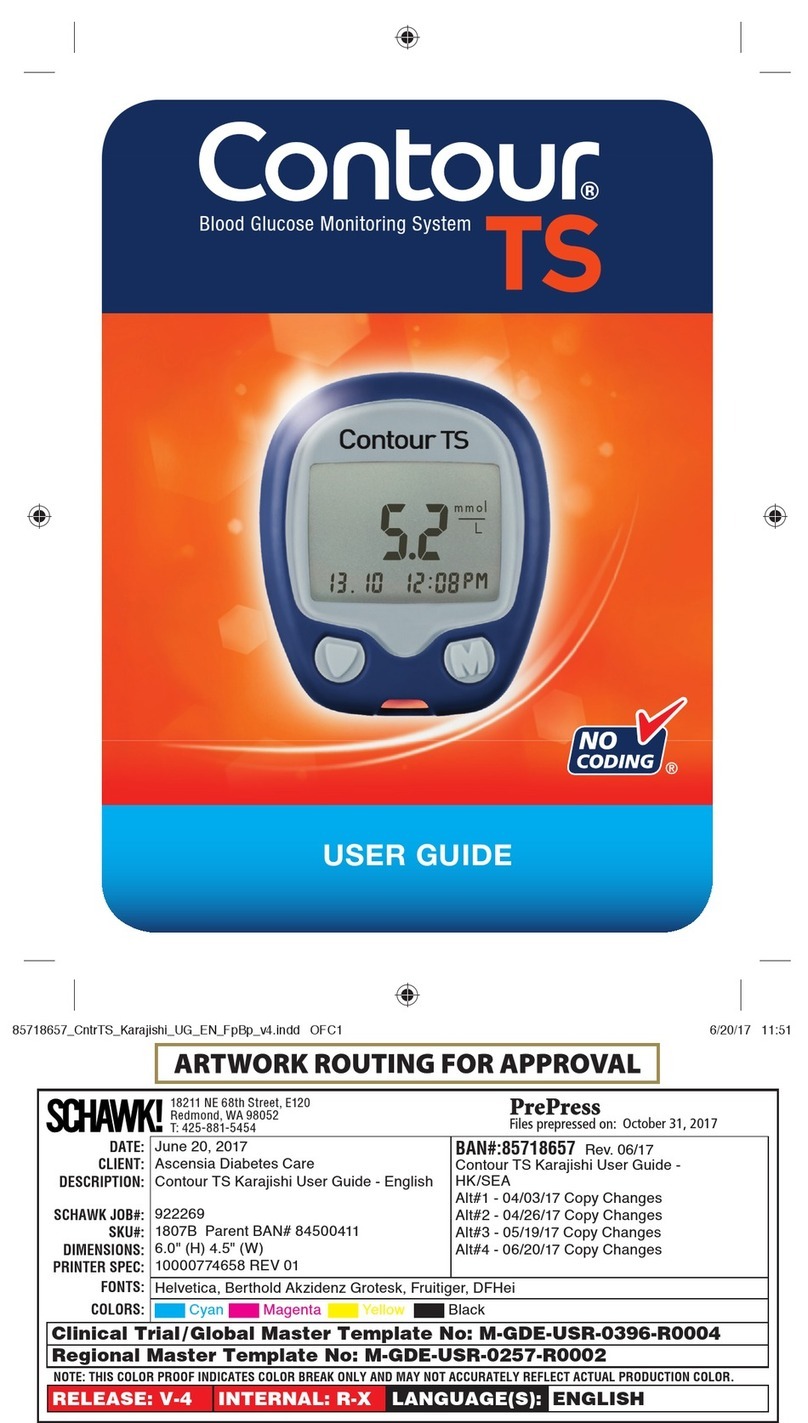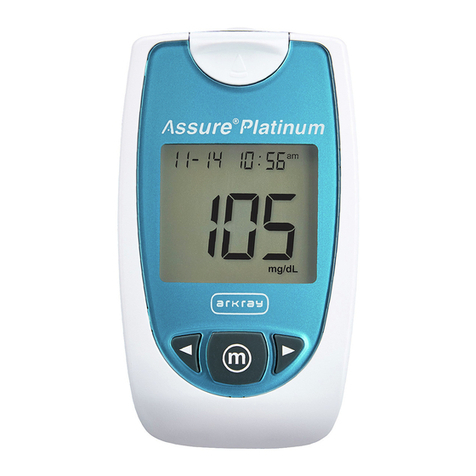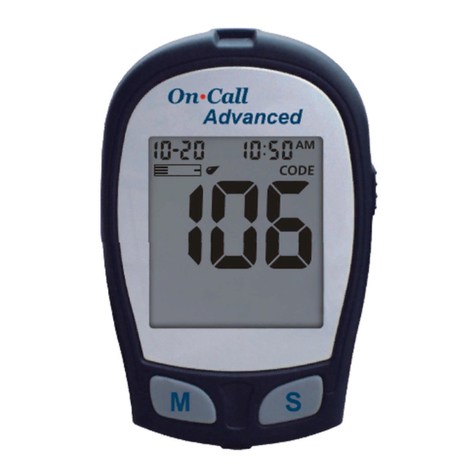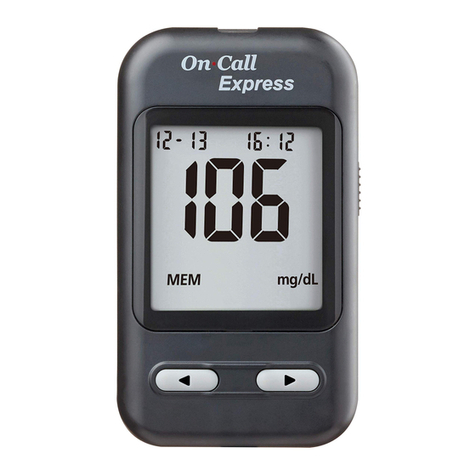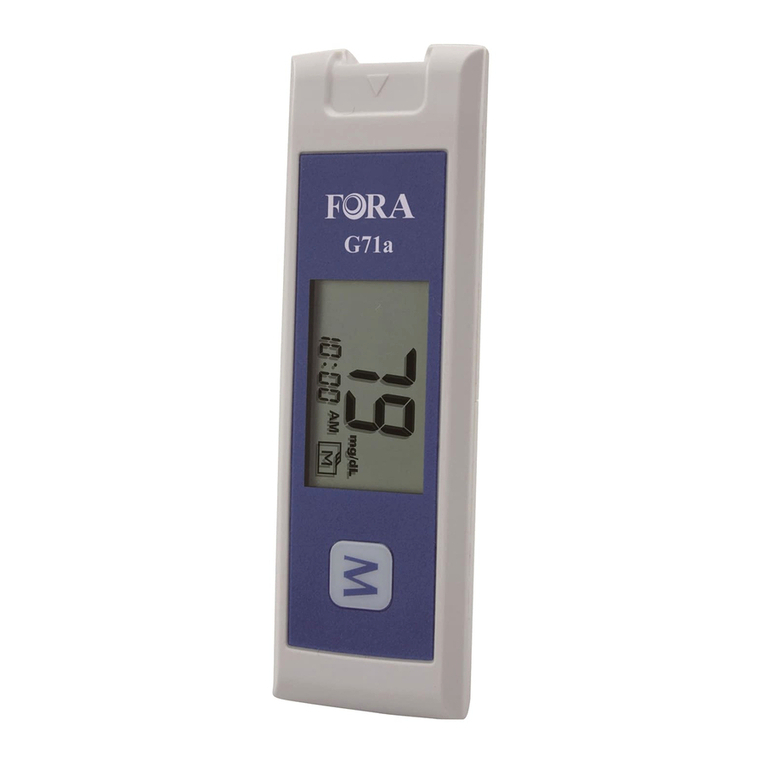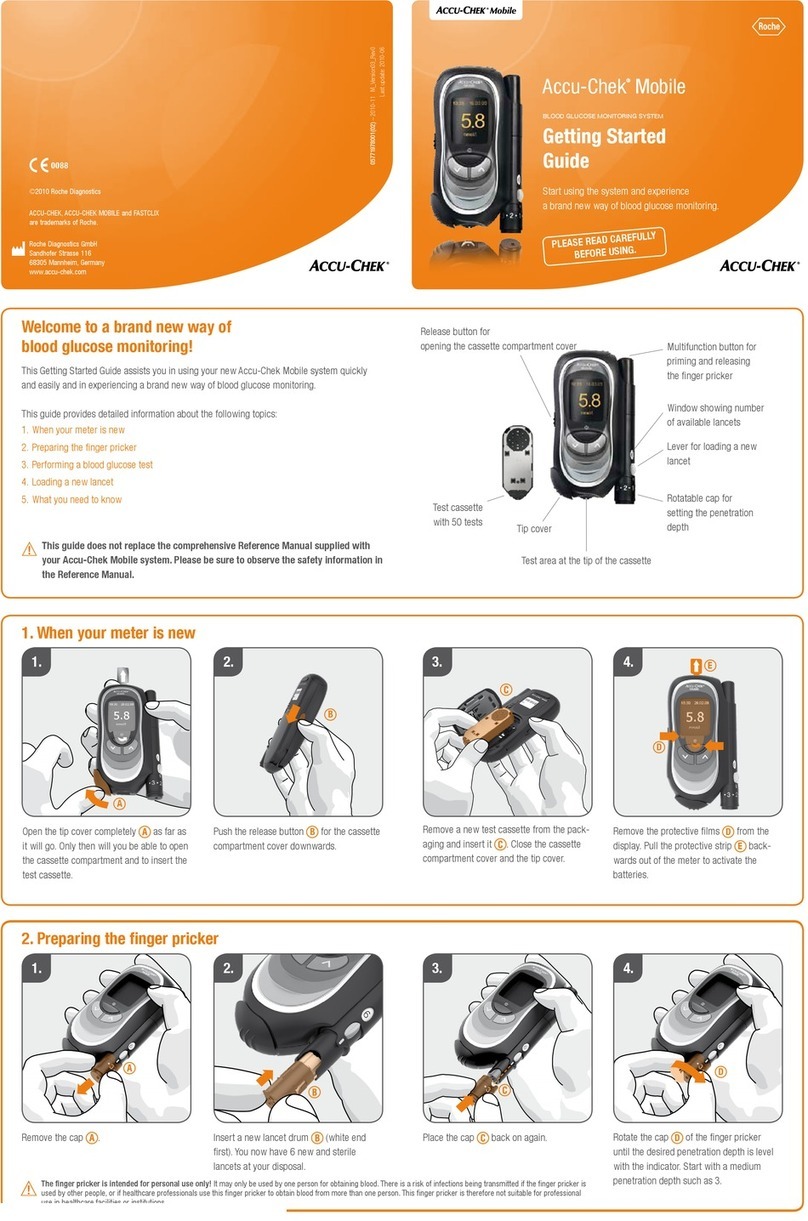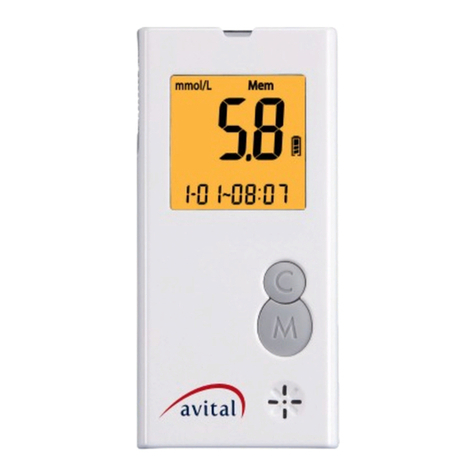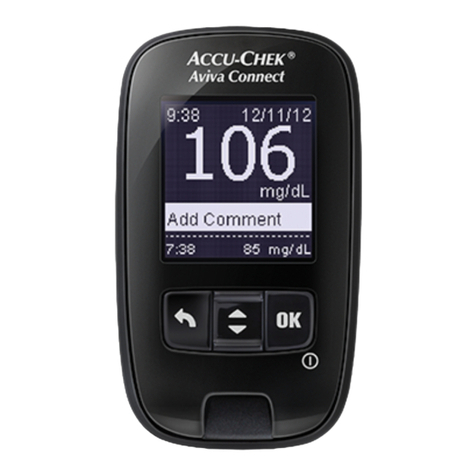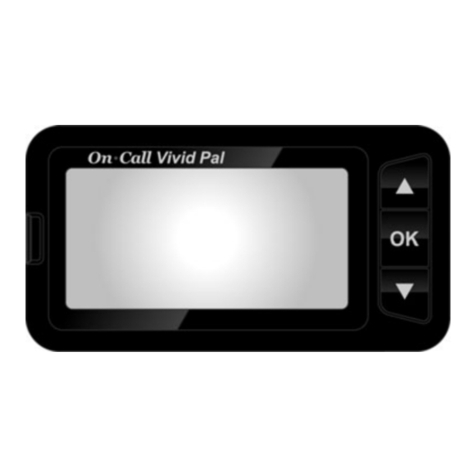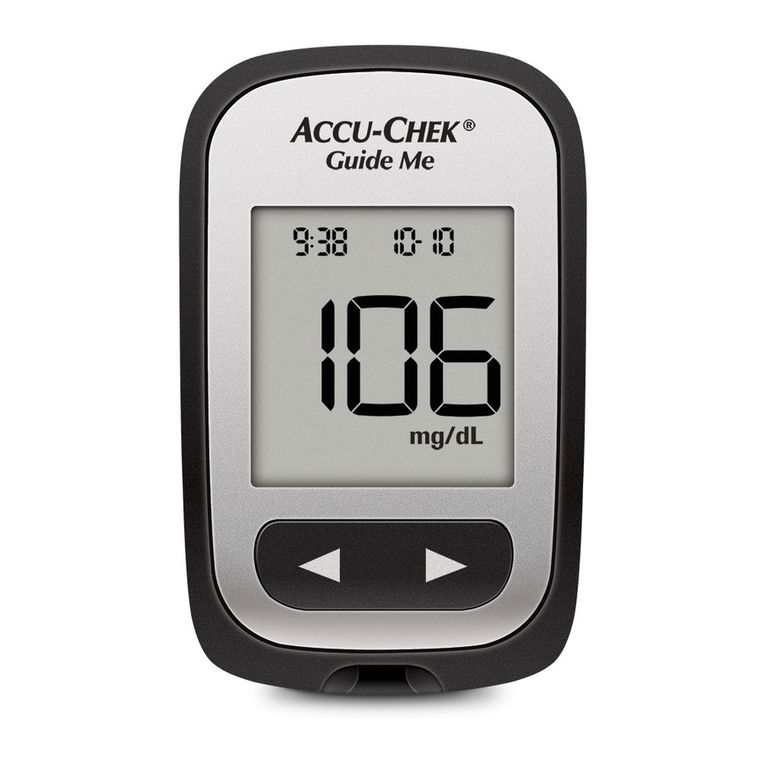INFINOVO MEDICAL i3 User manual


1
1
2
3
5
6
6
6
6
6
7
8
8
9
9
9
9
12
14
14
14
15
15
16
17
17
18
18
18
19
20
20
22
22
22
22
23
24
25
25
25
26
26
26
26
26
27
27
27
27
30
31
31
31

32
33
33
33
34
34
34
34
34
34
35
35
35
35
36
36
36
36
36
37
38
38



The Continuous Glucose Monitoring Systems is consist
of a disposable sensor, transmitter, App,and analysis
software, in which the core device is the sensor electrode.
It is recommended to wear the sensor to the abdomen and
minimize activities extent. The sensor electrode chemically
reacts with glucose in the hypodermic tissue fluid to generate
an electrical signal. Transmitter analysis and calculates the
electrical signal, and generates the blood glucose values,
which is transmitted to the mobile App. The user analysis
software downloads and collects data from the mobile App
for processing and analysis, then gives reports.
During the monitoring period, at least two finger blood
glucose values need to be inputted into the Continuous
Glucose Monitoring Systems every day for calibration. The
Continuous Glucose Monitoring Systems calculates an
average of every three minutes. The Continuous Glucose
Monitoring Systems can record 480 glucose readings every
24 hours, continuously monitor the blood glucose data for
14 days and form a continuous blood glucose curve. In
addition, dining, sports, medication and other activities
can be recorded.
1 Product overview
1.1 Product overview
Figure 1 Continuous Glucose Monitoring Systems
Warning
The sensors and transmitters of the Continuous Glucose
Monitoring Systems should be suitable for each other. The
products of different generations can not be connected to each
other and can not work. Make sure that the system uses the
correct INFINOVO Glunovo software version.
1

1.2 Sensor overview
1.2.1 Sensor overview
The continuous glucose monitoring sensor is a product
with a sterile sealed pouch. The sensor is mainly composed
of an applicator, a base and a sensor electrode. The base
consists of a PC base and an adhesive patch. The sensor
electrode is divided into three layers: semi-permeable
membrane, glucose oxidase layer and microelectrode. Insert
the sensor electrode into the subcutaneous tissue of the
abdomen and remove the applicator. The base is attached to
the abdomen for up to 14 days of monitoring. Please discard
disposable sensor after wearing.
1.2.2 The performance parameters of sensor
2

1.3 Transmitter overview
1.3.1 transmitter overview
The continuous glucose monitoring transmitter is a
component fixed on the sensor base with chips. Once the
transmitter is fixed in the sensor base and the sensor electrode
is activated through the App, the transmitter sends the blood
glucose message to the App. When properly worn, the
transmitter and App have a transmission range of 2 m without
obstruction. Wireless connection in the water is not very well,
so the range of connections in places like swimming pools,
bathtubs and waterbeds will be even smaller.
The battery of the transmitter can be used for no less
than 14 days.
1.3.2 The performance parameters of transmitter
3

1.3.3 EMC Statement
Guidance and manufacture's declaration –
electromagnetic emissions
The Continuous Glucose Monitoring Systems is suitable
for use in the specified electromagnetic environment (s) and
it has met the following standard’s emission requirements.
Guidance and manufacture's declaration –
electromagnetic immunity
The Continuous Glucose Monitoring Systems is suitable
for use in the specified electromagnetic environment (s) and
it has met the following immunity test levels. Higher immunity
levels may cause the Continuous Glucose Monitoring Systems’s
essential performance lost or degraded.
See the RF wireless
communication equipment
table in "Recommended
minimum separation
distances".
4
Recommended minimum separation distances
Nowadays, many RF wireless equipments have being
used in various healthcare locations where medical equipment
and/or systems are used. When they are used in close proximity
to medical equipment and/or systems, the medical equipment
and/or systems’ basic safety and essential performance may be
affected. Continuous Glucose Monitoring Systems has been
tested with the immunity test level in the below table and meet
the related requirements of IEC 60601-1-2:2014. The customer
and/or user should help keep a minimum distance between RF
wireless communications equipment and Continuous Glucose
Monitoring Systems as recommended below.

5
1.4 APP overview
Continuous glucose monitoring App is a mobile medical
application for Continuous Glucose Monitoring Systems to
receive and process glucose readings. The software displays
blood glucose readings, trend curves, trend arrows, and
transmitter status. It has functions of adding events, event
records, wearing records, alarm notifications, reading lists,
statistical analysis, data export, account management and
so on.
The main interface of App mainly displays blood glucose
readings, trend curves and trend arrows. App and transmitter
can be connected through Bluetooth, pairing for data
communication. A blood glucose meter is also needed to be
used with the Continuous Glucose Monitoring Systems.

2.3 Contraindications
Part of sensor need to pierce the skin, so it is recommended
that allergy and skin ulcers people use the device cautiously.
The product must be removed before magnetic resonance
imaging (MRI).
Taking acetaminophen while wearing the sensor may
falsely raise your sensor glucose readings.
2.4 Warning
Read the instructions carefully. Incorrect use of the
continuous blood glucose monitoring system may cause you
to misunderstand the information provided by the system or
affect the performance of the system and miss the low/high
blood glucose value.
Continuous blood glucose testing cannot be used as a
basis for diabetes diagnosis, such as insulin injection. It
cannot replace the blood glucose meter. The value of blood
glucose may differ from the reading of blood glucose. Using
glycemic readings as a diagnostic basis for diabetes may
result in low/high blood glucose.
Do not ignore the symptoms of high / low blood sugar.
If the blood glucose reading does not match the symptoms,
the blood glucose meter should be used to measure the blood
glucose even if the reading is within the normal range, so as
not to miss the low/high blood glucose value.
Calibrate at least once every 12 hours. Calibrating less
often than every 12 hours might cause sensor glucose
readings to be inaccurate, and you might miss a low or high
blood glucose value.
6
2 Safety Information
2.1 Application definition
The device is intended for continuous or periodic
recording of interstitial fluid glucose levels in adult patients
with diabetes aged 18 or older. The system is designed for
patients to use at home and in medical institutions. The
information is intended to supple, rather than replace, the
information obtained from standard glucose monitor like
traditional glucose meter and is intended to detect trends and
track patterns and to provide reference information for
patients to manage diabetes. The system provides real-time
blood glucose value, which is received and read by the App.
The blood glucose value data can be further imported into
the software for analysis of historical blood glucose values.
2.2 Important user information
In order to use this product safely, Please review your
product instructions before using your Continuous Glucose
Mon ito rin g S yst ems . T h e inst ruc tio ns inc l ude
contraindications, warnings, cautions, and other important
user information.Discuss with your doctor how to use
information to help you control your blood sugar. The
instruction manual contains important information about
system troubleshooting and equipment performance
characteristics

7
The device is not designed to remain in the body long-
term, or to be replaced ‘immediately’ with a similar or
identical device.
Portable RF communications equipment (including
peripherals such as antenna cables and external antennas)
should be used no closer than 30 cm (12 inches) to any part
of the [ME EQUIPMENT or ME SYSTEM], including cables
specified by the manufacturer. Otherwise, degradation of the
performance of this equipment could result.
2.5 Precautions
The sensors and transmitters of the Continuous Glucose
Monitoring Systems should be suitable for each other. The
products of different generations can not be connected to
each other and can not work. Make sure that the system uses
the correct INFINOVO Glunovo software version.
If the sensor is stored in the refrigerator, please take it
out half an hour before use. The sensor can be used at room
temperature.
Before opening the sensor package, wash your hands
with soap and water and dry them. Inserting the sensor with
dirty hands can contaminate the insertion site.
Before inserting the sensor, clean the skin with a
traditional method (such as an alcohol tablet) and let it dry .
This helps prevent infection. Do not insert the sensor until
the skin is dry so that the tape on the sensor base can be
attached better.
Change the insertion site each time. Using the same i
nsertion site too often may not allow the skin to heal, and
may cause scars or skin allergies.
It is forbidden to insert sensors in areas that may be
crush-squeezed, tattooed, or allergic. These sites are not ideal
for measuring blood glucose. Inserting sensors in these places
may affect the performance of the sensor, missing low/high
blood glucose values.
In rare cases, the sensor electrode may fracture. Don't
ignore it. If the sensor electrode breaks and there is no visible
sensor electrode on the skin, do not attempt to remove it.
Seek professional medical help in the condition of infection
symptoms or inflammation - redness, swelling or pain. If the
sensor electrode ruptures, please report to our technical
support department.
Do not use sensors that in damaged sterile packaging.
Using unsterilized sensors may lead to infection.
The storage temperature of the sensor is 2oC-25oC,
which can be transported at room temperature. The storage
time is the lifetime (8 months) of the sensor. If the t
emperature range of the refrigerator is 2oC-25oC, the sensor
can be stored in the refrigerator. Sensors should not be stored
in the freezer. Improper storage results in inaccurate blood
glucose readings and missing low/high blood glucose levels.

8
Blood glucose should not be calibrated in a rapid change
and the general rate of change is 0.11 mmol/L per minute. Do
not calibrate when the rising single arrow or double arrow is
displayed on the App interface which indicates that your blood
glucose level increased by 0.11-0.17 mmol/L or over 0.17
mmol/L per minute. At the same time, don't calibrate when
the drop single arrow or double arrow is displayed on the App
interface, indicating that your blood glucose level drops 0.11
-0.17 mmol/L or exceeds 0.17 mmol/L per minute. Calibration
can significantly affect the accuracy of blood glucose readings
when blood glucose rises or falls.
Rapid changes in blood sugar can affect the accuracy of
the system, such as during exercise or after meals.
When properly worn, the transmitter and App have a
transmission range of 2 m without obstruction. Wireless
connection in the water is not very well, so the range of
connections in places like swimming pools, bathtubs and
waterbeds will be much less. There are no tests for different
types of obstruction. If the distance between the transmitter
and App is more than 2 m or if the distance between them is
blocked by an obstruction, they may not be connected or the
connection distance may be shorter. You may miss the low/
high blood glucose level.
The transmitter can be reused in its lifetime and do not
discarded it.
3 Risk and Efficacy
3.1 Risk
Inserting sensors and wearing adhesive tapes are less
likely to cause infection, bleeding, pain or skin irritation
(redness, swelling, bruising, itching, scarring or discoloration).
In the clinical studies, a small number of patients experience
mild skin redness and swelling. If these symptoms occur, the
patient may feel uncomfortable at the location the sensor
inserted.
In rare cases, the sensor electrode may break and remain
in the body. This phenomenon did not appear in the clinical
study. If you feel the sensor is broken inside your skin, contact
your professional doctor and product technician.
It is forbidden to insert sensors within 8 cm of insulin
injection and placement of insulin pump. Insulin may affect
the performance of the sensor, missing low/high blood
glucose levels.
To calibrate the system, input the exact blood glucose
value measured by the glucometer within 3minutes. Inaccurate
input or blood glucose values exceeding 3minutes may affect
the performance of the sensor and result in missing low/high
blood glucose values.
In order to obtain more accurate blood glucose data, it
is recommended to test and calibrate the blood glucose before
going to bed at night and during fasting the next morning.

9
Sometimes the blood glucose readings may be slightly
different from the values measured by blood glucose meter.
In most cases, the blood glucose reading moves with the
blood glucose level and prompts after the blood glucose level
exceeds the target range.
If you are at high/low blood glucose levels, but you are
not prompted, you will not test your blood glucose with blood
glucose meter, and you will miss high/low blood glucose
levels.
3.2 Efficacy
The Continuous Glucose Monitoring Systems provides
more effective information than the blood glucose meter. In
14-day monitoring, the continuous blood glucose monitoring
system provides a blood glucose reading every three minutes
to help you observe the trend of blood glucose changes.
Dynamic information can help you check the current blood
glucose status, as well as the direction and speed of changes
in blood glucose. Recognizing trends in blood sugar can help
you take steps to avoid high/low blood sugar levels.
App alerts when blood glucose levels exceed your target
blood glucose range or when blood glucose drops or rises
rapidly. The alerts can remind you to take measures to avoid
low/high blood sugar.
4 App installation and System setting
4.1 App installation
The mobile App installation package or QR code can be
obtained from the company's website, packaging box of the
sensor or transmitter.
App is suitable for the system of Android 6, IOS10.4 and
above. Android is compatible with:
Samsung: Galaxy S8, Galaxy S8 Plus, Galaxy S9, Galaxy
S9 Plus;
VIVO: NEX, X21;
OPPO: R17, R17Pro;
OnePlus: 6;
Huawei: Mate10, Mate10Pro, P10, P10Pro, hornor9 series,
honor10 series;
MIUI: 8 series, MIX2 series.
When the prompt function is turned off, the transmitter
and App are not within the range of connection, and the
prompt cannot be obtained.
When you cannot hear the bell or feel the vibration, you
may not notice the prompt.
4.2 Setting the pairing connection between App and
transmitter

10
3.Click the App icon, run the App, enter the account
management interface, enter the name and phone number, and
click save to enter the device addition interface;
4.Click [Add Device] to enter the Select Device interface.
Then the mobile phone will search for nearby transmitters,
and list the searched transmitters, select the transmitter name
to be connected [GN-xxxxxxx]; if there is no name of the
transmitter that needs to be connected, click [Search Device]
again to continue the search;
5.Click [GN- xxxxxxx] to enter the pair code and the
[disconnect] icon will display; W ait for the App to connect
to the transmitter automatically .
This section helps you to make the first App settings.
Read this chapter before the operation begins.
1.Remove the transmitter from the package
2.Turn on the bluetooth of the mobile phone and install
the App software;

11
6.If the App automatically connects to the transmitter
unsuccessful, you can directly click the [Disconnect] icon to
reconnect. After the connection between the transmitter and
App is successful, the [Connected] icon appears. You can use
the App to operate the transmitter.
After adding the transmitter, the connection status icon
of the main interface of the App will prompt the connection
status of the App and the transmitter. After adding the device,
the App will automatically connect the selected transmitter.
If the connection is unsuccessful, you can click the
connection status icon and manually connect the transmitter.
Contraindications
Part of sensor need to pierce the skin, so it is
recommended that allergy and skin ulcers people use
the device cautiously. The product must be removed
before magnetic resonance imaging (MRI).
Caution
When properly worn, the transmitter and App
have a transmission range of 2 m without obstruction.
Wireless connection in the water is not very well, so
the range of connections in places like swimming
pools, bathtubs and waterbeds will be much less.
There are no tests for different types of obstruction.
If the distance between the transmitter and App is
more than 2 m or if the distance between them is
blocked by an obstruction, they may be disconnected
or the connection distance may be shorter. You may
miss the low/high blood glucose level.

12
4.3 Menu settings
The Settings menu includes account management, unit
Settings, current devices, help and other functions.
1.In the main interface of App, click the icon in the upper
right corner to enter the main menu.
2.In the main menu interface, click [Settings ] to enter
the settings menu.
4.3.1 Unit setting
Click the[unit Settings]in the Settings menu, and the
"unit Settings" dialog box pops up, and click on the units
you need to set up.

13
4.3.2 Account Management
In the Settings menu, click[account management]to enter
the account management interface. Account management
interface can set basic user information, including name,
gender, date of birth, email, mobile phone number, etc.
4.3.3 Current device
1.Click [current device] in the Settings menu to enter
the current device interface, which displays the current
emitter device name, emitter address name and sensor batch
number.
2.When the transmitter device is unable to connect to
or operate the transmitter due to damage or insufficient
power, click [cancel the device]. After the prompt dialog
box pops up and confirms, uncouple the App and the current
device.
3.After logging off the device, if you want to add a new
transmitter device to continue the detection process, click
[Add Device] to enter the Select Device interface. New
transmitter devices can be searched and selected to begin
new sensor detection.
4.Click [transmitter model] and [transmitter software
version number] to read the transmitter model and software
version number.

14
5 Sensor insertion and startup
Blood glucose meters and test strips are not included in
the continuous blood glucose test system. When calibrating,
you need to prepare a blood glucose meter and a test strip.
The sensor continuously monitor displays blood glucose
readings for 14 days. The following steps will show you how
to insert the sensor.
Please read the instructions.
Warning
In rare cases, the sensor electrode may fracture.
Don't ignore it. If the sensor electrode breaks and there
is no visible sensor electrode on the skin, do not
attempt to remove it. Seek professional medical help in
the condition of infection symptoms or inflammation -
redness, swelling or pain. If the sensor electrode
ruptures, please report to our technical support
department.
No safety hazard was found in the patient's
residual rupture sensor electrode during in vitro NMR
test. There was no obvious migration or heating of the
sensor electrode, and the imaging was limited to the
area around the sensor electrode.
5.1 Preparation
Check the expiry date on the sensor package. insert the
sensor before the expiration date.
Warning
The storage temperature of the sensor is 2oC-
25oC, which can be transported at room temperature.
The storage time is the lifetime (8 months) of the
sensor. If the temperature range of the refrigerator is
2oC-25oC, the sensor can be stored in the refrigerator.
Sensors should not be stored in the freezer. Improper
storage results in inaccurate blood glucose readings
and missing low/high blood glucose levels.
Caution
If the sensor is stored in the refrigerator, please
take it out half an hour before use. The sensor can
be inserted at room temperature.
5.2 Remove the sensor
Caution
Do not use sensors with damaged or opened
sterile packaging. Using an unsterilized sensor can
cause infection.

15
Wash your hands thoroughly and dry them.
Remove the sensor from the package and check it
carefully to make sure it is intact.
The applicator is a disposable assistive device used alone.
Safety lock can prevent accidental release of the sensor
electrode before you are ready.
5.3 Selection of insert site
Caution
It is forbidden to insert sensors in areas that may be
crush-squeezed, tattooed, or allergic. These sites are not
ideal for measuring blood glucose.
It is forbidden to insert sensors within 8 cm of insulin
injection and placement of insulin pump.
Performance of the sensor may be affected when
inserted in those areas, resulted in missing low/high
blood glucose levels.
It is recommended to select a position other than 5 cm
from the navel in the abdomen where the sensor is to be placed.
The position of the sensor is generally selected to be flat, not
easily deformed, and not easily rubbed by a belt or a seat belt.
It is forbidden to insert sensors within 8 cm of insulin
injection and placement of insulin pump.
The area where put the sensor needs to be shaved and
cleaned so that the adhesive tape is kept firm.
Change the insertion site each time.
Make sure there are no traces of lotions, perfumes, or
drugs on the sensor.
5.4 Place sensor
Caution
Continuous blood glucose testing cannot be used as
a basis for diabetes diagnosis, such as insulin injection.
It cannot replace the blood glucose meter. The value of
blood glucose may not be consistent with the reading of
blood glucose. Using glycemic readings as a diagnostic
basis for diabetes may result in low/high blood glucose.
1.Before inserting the sensor, clean the skin with a traditional
method (such as an alcohol tablet) and let it dry.
2.Remove the protective paper from the bottom of the s
ensor base. Hold the sensor by the applicator barrel, and don
not touch the adhesive tape.
Other manuals for i3
1
This manual suits for next models
1
Table of contents
Other INFINOVO MEDICAL Blood Glucose Meter manuals


